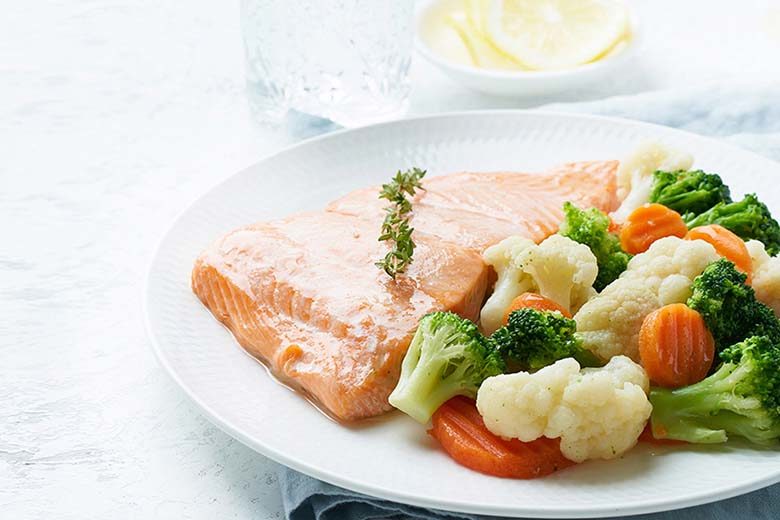
Along with being a source of important nutrients including omega-3 fatty acids, protein and vitamin D, eating seafood may lead to better brain and heart health. If you’re not sure how to prepare fish or don’t like the flavor or texture, use these tips to increase your cooking confidence.
Preparation Pointers
Fold and tuck. It’s essential to have a fillet of equal thickness to ensure even cooking. If one side is thinner than the other, tuck the smaller end under the fillet to increase that side’s height and create a consistent thickness.
Flip with ease. An easy way to prepare fish is sautéing it in a hot skillet. To ensure fillets don’t tear or flake apart when turning, coat the pan with oil or cooking spray and use a fish spatula, which typically has a thin metal head with slots and is longer than the average spatula. If cooking a fillet with skin, start skin-side down, as it’s easier to slide the spatula under the crispy skin to flip.
Check the flake or shape. Overcooking seafood is a common mistake, resulting in dry fish or rubbery shellfish. The general guideline for cooking fish fillets is about 10 minutes per inch of thickness in a 400°F preheated oven. Check a few minutes before the cooking time is up to see if the fish has turned opaque and has reached a minimum internal temperature of 145°F. It should flake easily with a fork when done. Cook shrimp in a hot pan for 4 to 5 minutes or until they form a C-shape (when shrimp have an O-shape, they’re overcooked), and their flesh appears opaque and pearly or white in color.
Skip the thaw. Place frozen salmon fillets skin-side down on a baking sheet, cover with foil and bake 15 minutes in an oven preheated to 425°F. Remove the foil and cook for another 8 to 10 minutes, until fillets begin to flake and reach an internal temperature of 145°F. Frozen shrimp can be seasoned with spices and put directly under a broiler preheated to high on a preheated sheet pan. They’ll be ready in about 5 minutes.
Meet the microwave. A surprising method to some, microwaving works for both thin and thick fish fillets. Swirl a little oil in a shallow glass pie plate and add up to four 4-ounce fillets (use the fold and tuck method if fillets are uneven). Cover with plastic wrap, leaving a small vent for steam to escape. Microwave on high for about 3 minutes (no flipping required).
Enhancing Flavor
Start with mild. Thin white fish is a blank slate for any flavor. Season it with herbs and spices such as oregano, chili powder or cumin before baking or sautéing for a taco filling with salsa and guacamole. Or, season it with black pepper, salt and lemon juice, cook and then serve with garlicky pesto on top.
Incorporate into meals. Seafood can easily be added into family favorites. Mash canned tuna or canned crab into tomato sauce for pasta, use flaked cooked salmon to stuff burritos with cheese or cook chopped shrimp in stir-fry and serve with rice.
Crust it. Adding a flavorful and crunchy crust can transform texture and make fish more appealing. Crushed cornflakes, cornmeal, finely chopped nuts or whole-wheat panko breadcrumbs mixed with grated aged cheese all make an irresistible crust. First coat the fillet in flour and then in a beaten egg mixture before dredging in your chosen coating. Cook to an internal temperature of 145°F, then serve with a dunking sauce such as ketchup or yogurt mixed with olive oil, lemon juice and chives.
Make a cake. Canned tuna, salmon or baby shrimp are handy ingredients for assembling quick fish patties or burgers. Mix two drained 5-ounce cans with 1 egg, ¾ cup breadcrumbs or mashed baked potato, ¼ cup diced onion, bell pepper or celery, and your favorite spices such as Italian seasoning or red pepper flakes. Form into patties and cook in a skillet with hot oil for 3 to 5 minutes per side.
References
Omega-3 Fatty Acids. National Institutes of Health Office of Dietary Supplements website. Revised October 17, 2019. Accessed June 30, 2020.
Safe Minimum Cooking Temperatures Charts. Foodsafety.gov website. Revised April 12, 2019. Accessed June 30, 2020.

